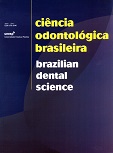Efeitos do risedronato na reparação óssea de ratos machos e fêmeas com osteopenia
DOI:
https://doi.org/10.14295/bds.2005.v8i3.433Abstract
O objetivo deste trabalho foi avaliar histomorfológica e morfometricamente a ação do risedronato na reparação óssea de ratos com osteopenia. Utilizaram-se trinta ratos machos e trinta fêmeas castrados e após um mês deste procedimento, confeccionou-se um defeito ósseo de 3mm de diâmetro nas tíbias direitas dos animais. Estes foram divididos em quatro grupos: I (machos controle); II (machos tratados); III (fêmeas controle); IV (fêmeas tratadas). Administrou-se nos grupos II e IV, após execução do defeito, 0,1mg/Kg/dia de risedronato na água de beber, durante cinco dias e nos grupos I e III, somente água. O sacrifício dos animais ocorreu sete, 14 ou 28 dias após a realização do defeito. Os cortes histológicos foram analisados qualitativa e quantitativamente. Os dados obtidos na histomorfometria foram submetidos à análise estatística (ANOVA e Teste de Tukey, p≤0,05) que revelou um maior preenchimento ósseo nos ratos machos, sobretudo aos sete e 28 dias, independente da utilização do medicamento. Evidenciou-se, ainda, maior grau de maturação do osso neoformado nos ratos machos. Concluiu-se que o tratamento com risedronato mostrou-se ineficaz na reparação óssea e que a diminuição hormonal causou maior prejuízo ao processo de neoformação óssea em fêmeas quando comparado aos efeitos da deficiência hormonal em machos.
Downloads
Downloads
Published
How to Cite
Issue
Section
License
Brazilian Dental Science uses the Creative Commons (CC-BY 4.0) license, thus preserving the integrity of articles in an open access environment. The journal allows the author to retain publishing rights without restrictions.
=================




























